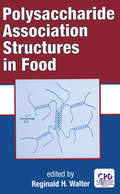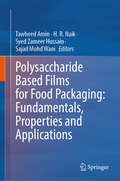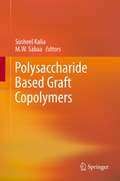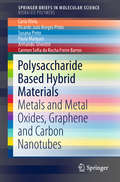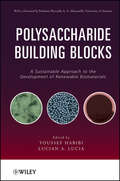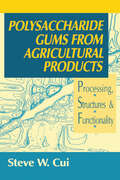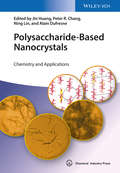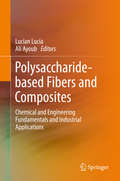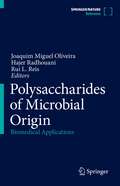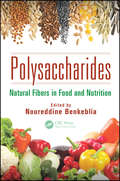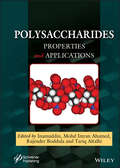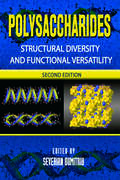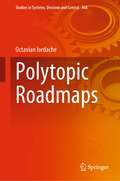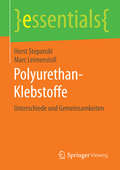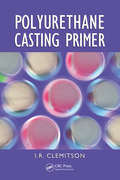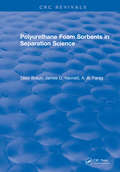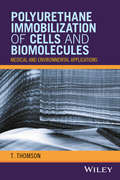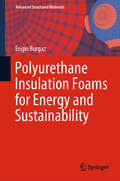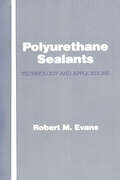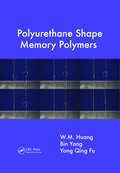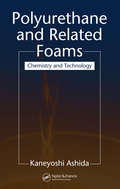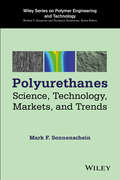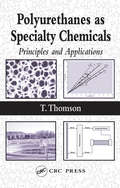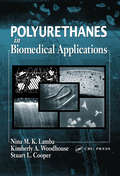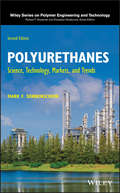- Table View
- List View
Polysaccharide Association Structures in Food (ISSN)
by Reginald H. WalterFocuses on the physical-chemical origins and structures formed by the association of aqueous, dispersed polysaccharides with related and unrelated chemical species. Covers the origin of polysaccharide supramolecular assemblies; polysaccharide molecular structures; gel formation and ultrastructure in food polysaccharides; structures and phase transitions of starch polymers; microcrystalline cellulose technology; cyclodextrins; starch-lipid interactions; interactions in whey protein/polysaccharide mixtures; and more.
Polysaccharide Based Films for Food Packaging: Fundamentals, Properties and Applications
by Syed Zameer Hussain Tawheed Amin Sajad Mohd Wani H. R. NaikThis book offers an extensive overview of the current and future potential of polysaccharides-based films, providing in-depth coverage of the fundamentals and basics of polysaccharide-based films.Aimed at students, scholars, scientists, and food packaging professionals, this book delves into the properties and applications of polysaccharide-based edible films in the food packaging industry. It provides insights and pathways for widening the applications of polysaccharide-based films to maximize their benefits in various industries and research institutes worldwide. With a wealth of scientific knowledge presented in an organized manner, this book serves as a valuable reference for researchers and professionals in food and pharmaceutical industries, as well as those in research and development (R&D) institutes.
Polysaccharide Based Graft Copolymers
by Susheel Kalia M. W. SabaaRenowned experts give all essential aspects of the techniques and applications of graft copolymers based on polysaccharides. Polysaccharides are the most abundant natural organic materials and polysaccharide based graft copolymers are of great importance and widely used in various fields. Natural polysaccharides have recently received more attention due to their advantages over synthetic polymers by being non-toxic, biodegradable and available at low cost. Modification of polysaccharides through graft copolymerization improves the properties of polysaccharides. Grafting is known to improve the characteristic properties of the backbones. Such properties include water repellency, thermal stability, flame resistance, dye-ability and resistance towards acid-base attack and abrasion. Polysaccharides and their graft copolymers find extensive applications in diversified fields. Applications of modified polysaccharides include drug delivery devices, controlled release of fungicides, selective water absorption from oil-water emulsions, purification of water etc.
Polysaccharide Based Hybrid Materials: Metals and Metal Oxides, Graphene and Carbon Nanotubes (SpringerBriefs in Molecular Science)
by Paula Marques Carla Vilela Ricardo João Pinto Susana Pinto Armando Silvestre Carmen Sofia da Rocha Freire BarrosThis brief explores polysaccharides, the most abundant family of naturally occurring polymers, and explains how they have gained considerable attention in recent decades as a source of innovative bio-based materials. The authors present a range of material including an extensive array of polysaccharide hybrid nanomaterials with distinct applications. The most recent knowledge regarding polysaccharide-based hybrid nanomaterials with metal and metal oxide nanoparticles (NPs), carbon nanotubes and graphene is presented as well as the main polysaccharides, namely cellulose, chitin and chitosan, starch and their most relevant derivatives. The book features a description of important production methodologies, properties, and applications of these types of hybrids.
Polysaccharide Building Blocks
by Youssef Habibi Lucian A. LuciaThis book is an archival reference for the evolving field of biomaterials and their applications in society, focusing on their composition, properties, characterization, chemistry and applications in bioenergy, chemicals, and novel materials and biomaterials. It has broad appeal due to the recent heightened awareness around bioenergy and biomass as potential replacements for petroleum feedstocks. The book is divided into three parts: cellulose-based biomaterials, chitin and chitosan biomaterials, and hemicelluloses and other polysaccharides. Each chapter addresses a separate biomaterial, discussing its chemical, physical, and biological attributes, and hones in on each compound's intrinsic tunability for numerous chemical transformations. In the current quest for a "green" economy and resources, this book will help inspire scientists towards novel sources for chemicals, materials, and energy in the years to come.
Polysaccharide Gums from Agricultural Products: Processing, Structures and Functionality
by Steve W. CuiThis new reference presents the most recent information on new and potential food hydrocolloids originated from agricultural products, including o yellow mustard gum o flaxseed gum o cereals (wheat, barley, oat, and corn)o psyllium fenugreek o soybean. Polysaccharide Gums from Agricultural Products: Processing, Structures and Functionality addresse
Polysaccharide-Based Nanocrystals: Chemistry and Applications
by Alain Dufresne Jin Huang Ning Lin Peter R. ChangPolysaccharide nanocrystals, an emerging green nanoingredient (nanomaterial) with high crystallinity obtained by acid hydrolysis of biomass-based polysaccharides, are of scientific and economic significance owing to their abundance, biodegradation potential, and fascinating functional performance. This versatile class of materials can be used in nanocomposites such as rubber or polyester, and in functional materials such as drug carriers, bio-inspired mechanically adaptive materials or membranes, to name but a few. This book encompasses the extraction, structure, properties, surface modification, theory, and mechanism of diverse functional systems derived from polysaccharide nanocrystals. This highly sought-after trendy book is currently the only monograph devoted to the most current knowledge pertaining to this exciting subject area. It is ideal for researchers and stakeholders who wish to broaden and deepen their knowledge in the fast-moving and rapidly expanding R&D field of polymeric materials.
Polysaccharide-based Fibers and Composites
by Lucian Lucia Ali AyoubThis book includes chapters based on the potential uses of polysaccharides such as fibers in food and non-food applications. The complexity of their synthesis in plants, the highly multidisciplinary character of polysaccharide research, and the wide variety of applications from food to clothing to energy are addressed in this volume. The authors describe in detail how these latter grand challenges are of great importance in research, especially in the midst of enormous overpopulation and economic issues. Therefore, the volume contributes additional information to the chemical, nutritional, medical, and energy roles of these bio-based products, finding applications in diverse fields of their raw and composite forms. This volume is a useful resource for graduate students and contains themes for instructors and senior research leaders. Written by internationally renowned experts, it is aimed at workers in polymer laboratories, classrooms, and policy makers.
Polysaccharides of Microbial Origin: Biomedical Applications
by Rui L. Reis Joaquim Miguel Oliveira Hajer RadhouaniThis book provides a comprehensive analysis of microbial polysaccharides, their current uses, and highlights biomedical opportunities. The topics comprise principally a) their extraction, isolation, purification and advanced production processes; b) characterization of their structural, physicochemical, and biological properties, among others, by several techniques; c) description of the advanced functionalization and modification methods for the polysaccharide based-material; and d) their applications and uses in medical and pharmaceutical fields. Each chapter is written by world-renowned academics and practitioners on their field. This is an essential reference for students in biomedical, chemical, material, and microbiology engineering as well as researchers and professionals in the medical field.
Polysaccharides: Natural Fibers in Food and Nutrition
by Noureddine BenkebliaThis book reviews the evidence supporting the influence of plant fibers on our daily life by either having impacts on our nutrition or improving processed foods for human and animal feeding. By bringing new information and updating existing scientific data, this book will also be a consistent source of information for both professional and non-prof
Polysaccharides: Properties and Applications
by Inamuddin Mohd Imran Ahamed Rajender Boddula Tariq AltalhiThis book provides the whole spectrum of polysaccharides from basic concepts to commercial market applications. Chapters cover various types of sources, classification, properties, characterization, processing, rheology and fabrication of polysaccharide-based materials and their composites and gels. The applications of polysaccharides include in cosmetics, food science, drug delivery, biomedicine, biofuel production, marine, packaging, chromatography and environmental remediation. It also reviews the fabrication of inorganic and carbon nanomaterials from polysaccharides. The book incorporates industrial applications and will fill the gap between the exploration works in the laboratory and viable applications in related ventures.
Polysaccharides: Structural Diversity and Functional Versatility, Second Edition
by Severian DumitriuCompletely revised and expanded to reflect the latest advancements in the field, Polysaccharides: Structural Diversity and Functional Versatility, Second Edition outlines fundamental concepts in the structure, function, chemistry, and stability of polysaccharides and reveals new analytical techniques and applications currently impacting the cosmeti
Polytopic Roadmaps (Studies in Systems, Decision and Control #368)
by Octavian IordacheThis book is useful to engineers, researchers, entrepreneurs, and students in different branches of production, engineering, and systems sciences. The polytopic roadmaps are the guidelines inspired by the development stages of cognitive-intelligent systems, and expected to become powerful instruments releasing an abundance of new capabilities and structures for complex engineering systems implementation. The 4D approach developed in previous monographs and correlated with industry 4.0and Fourth Industrial Revolution is continued here toward higher dimensions approaches correlated with polytopic operations, equipment, technologies, industries, and societies. Methodology emphasizes the role of doubling, iteration, dimensionality, and cyclicality around the center, of periodic tables and of conservative and exploratory strategies. Partitions, permutations, classifications, and complexification, as polytopic chemistry, are the elementary operations analyzed. Multi-scale transfer, cyclic operations, conveyors, and assembly lines are the practical examples of operations and equipment. Polytopic flow sheets, online analytical processing, polytopic engineering designs, and reality-inspired engineering are presented. Innovative concepts such as Industry 5.0, polytopic industry, Society 5.0, polytopic society, cyber physical social systems, industrial Internet, and digital twins have been discussed. The general polytopic roadmaps, (GPTR), are proposed as universal guidelines and as common methodologies to synthesize the systemic thinking and capabilities for growing complexity projects implementation.
Polyurethan-Klebstoffe: Unterschiede und Gemeinsamkeiten (essentials)
by Horst Stepanski Marc LeimenstollDie Autoren zeigen anschaulich dieunterschiedlichen chemischen Zusammensetzungen der verschiedenen Arten vonPolyurethan-Klebstoffen und welche Gemeinsamkeiten diese andererseits haben. Dadurchmöchten die Autoren mehr Verständnis für die Breite der Möglichkeiten wecken,die der reich bestückte Baukasten der Polyurethan-Chemie denKlebstoff-Formulierern bietet. Dies erleichtert angesichts sich wandelndertechnologischer Anforderungen die Kommunikation zwischen Klebstoffanwendern und-herstellern.
Polyurethane Casting Primer
by I.R. ClemitsonOmitting complicated chemistry concepts, Polyurethane Casting Primer presents practical details on the casting of polyurethane products to assist readers in their daily work. It covers fundamental methods, explores hands-on design and production topics, and keeps theory to a minimum.The book fully explains casting and allied processes. Starting fro
Polyurethane Foam Sorbents in Separation Science
by BraunThe purpose of this book is to present in a monographic and systematised form a review of all the literature devoted to polyurethane-based polymeric sorbents in separation chemistry. The primary types of sorbents dealt with are polyurethane foams and open-pore polyurethanes. The structure of the monograph follows this dichotomy. A book of this nature should stimulate thinking and incite its reader to consult the original literature. It will, however, not make such a consultation superfluous. A fair amount of the results described in this monograph constitute the main activity of investigation which took place in the authors laboratories during the past decade.
Polyurethane Immobilization of Cells and Biomolecules: Medical and Environmental Applications
by T. ThomsonThis book provides a comprehensive review of the chemistry and research illustrating the benefits of polyurethane for immobilizing cells, with dozens of case studies in medical devices and environmental engineering.• Offers an essential resource for medical and environmental scientists• Provides a multidisciplinary and lucid writing style that uses little or no jargon• Extrapolates current technology into advanced areas, especially environmental remediation and medical devices• Fills the gap between immobilization research and practical applications
Polyurethane Insulation Foams for Energy and Sustainability (Advanced Structured Materials #111)
by Engin BurgazThis review book focuses on the structure-property relationships of polyurethane nanocomposite foams in comparison with those of conventional polyurethane composite foams. The thermal insulation properties of polyurethane foam nanocomposites are discussed along with other traits such as their morphology, mechanical and thermomechanical properties, thermal degradation and flammability, energy absorption and saving capability, recycling and recovery behavior. In turn, the book discusses potential applications of PU nanocomposite foams and outlines the main problems that remain to be solved with regard to this important topic.
Polyurethane Sealants: Technology & Applications
by Robert M. EvansPolyurethane sealants are used in many high-volume applications such as construction and automotive. This volume provides an in-depth, illustrated survey of both the technology and applications. The detailed information will be useful to all those involved in the research, development, processing, evaluation and use of sealants for high-volume applications.
Polyurethane Shape Memory Polymers
by W.M. Huang Bin Yang Yong Qing FuShape memory polymers (SMPs) are some of the most important and valuable engineering materials developed in the last 25 years. These fascinating materials demonstrate remarkably versatile properties-including capacity for actuation and stimulus responsiveness-that are enabling technologists to develop applications used to explore everything from th
Polyurethane and Related Foams: Chemistry and Technology
by Kaneyoshi AshidaPolyurethane and Related Foams: Chemistry and Technology is an in-depth examination of the current preparation, processing, and applications of polyurethanes (PURs) and other polymer foams. Drawing attention to novel raw materials, alternative blowing agents, and new processing methods, the book accentuates recent innovations that meet incre
Polyurethanes
by Mark F. SonnenscheinA complete overview of a key plasticOne of the most versatile polymer materials, polyurethanes have a unique chemical nature that allows for shaping and molding to fit all sorts of consumer and industrial products - seat cushions, carpets, insulation, coatings, and refrigerators to name a few. Despite its popular uses, polyurethane science has only relatively recently achieved appreciation for the richness of its expression as a polymer family. This book provides a thorough presentation of polyurethane science, technology markets and trend analysis based on recent patents. Although it does not provide ultimate detail (such as explicit information typically in patents), the book has a flow and continuity that allows readers to find all the background necessary to understand any other more detailed polyurethane information found elsewhere.Anyone involved in the polymer and plastics industry will find this book a key resource with features that include:An in-depth summary of the current state of polyurethane research and knowledgeDiscussion of the applications, manufacture, and markets for polyurethanesAnalytical methods, reaction mechanisms, morphology, theoretical techniques, and the selection of chain extendersPolyurethane flexible and rigid foams, elastomers, coatings, adhesives, and medical applicationsIn-depth coverage of governmental regulations, non-isocyanate/non-phosgene routes to polyurethane structure, and industrial routes to environmental, health, and safety risk mitigation
Polyurethanes as Specialty Chemicals: Principles and Applications
by Timothy ThomsonLooking beyond the traditional applications of polyurethanes (PUR), Polyurethanes as Specialty Chemicals presents a different approach to polyurethane chemistry by examining a range of new products and new research for both environmental and medical applications. This book is also the first in its field to provide useful design tools for product de
Polyurethanes in Biomedical Applications
by NinaM.K. LambaPolyurethanes in Biomedical Applications studies the use of polyurethanes in implanted medical devices. This analysis describes the concepts of polymer science, the manufacture of polyurethanes, and the biological responses to implant polyurethanes, reflecting the developments in biomaterials science and the interdisciplinary nature of bioengineering.
Polyurethanes: Science, Technology, Markets, and Trends (Wiley Series on Polymer Engineering and Technology)
by Mark F. SonnenscheinThis book, cohesively written by an expert author with supreme breadth and depth of perspective on polyurethanes, provides a comprehensive overview of all aspects of the science and technology on one of the most commonly produced plastics. Covers the applications, manufacture, and markets for polyurethanes, and discusses analytical methods, reaction mechanisms, morphology, and synthetic routes Provides an up-to-date view of the current markets and trend analysis based on patent activity and updates chapters to include new research Includes two new chapters on PU recycling and PU hybrids, covering the opportunities and challenges in both
